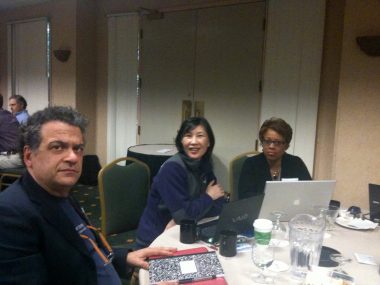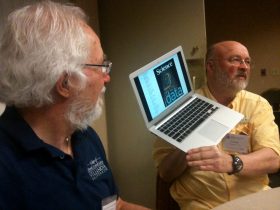Michelle Ferrier, associate professor in the School of Communications, was invited to a two-day workshop April 29-30 in Tucson, Ariz., to help develop strategies for interdisciplinary computing in higher education.

The workshop, funded by the National Science Foundation, allowed 37 national and international faculty and administrators to identify the motivations for faculty participation in interdisciplinary work, motivations for institutions for engaging in interdisciplinary work and barriers to a climate of interdisciplinary exchange.
Ursula Wolz and Boots Cassel of The College of New Jersey are the lead researchers on the NSF project. Their goals are to capture exemplars of what is working, to identify the range of possibilities and to answer the question of how the NSF can best facilitate interdisciplinary computing.
“The world has gone interdisciplinary and some of us are excited, some of us are fearful – but we need to figure out how to do this at our institutions,” Wolz said.
Ferrier was invited to share her experiences around digital media and computational journalism and the cross-disciplinary alliances and courses that have expanded student learning and job opportunities.
According to a working definition offered by Rich Gordon of Northwest University and Kim Pearson of The College of New Jersey, computational journalism applies technology in ways that engage users/consumers and motivates them to be informed about and to participate in the public sphere.
“Our conversation is not about teaching students computer programming,” Ferrier said. “The coursework we’ve initiated enhances computational thinking and expands the student’s abilities to see problems from different perspectives and to create innovation.”
Computational thinking includes the practices of decomposition, pattern recognition, concept abstraction and algorithm design. It is adapted from the development processes of software engineers.
“Our graduates are already working in multidisciplinary teams in some of their work environments. They need to bring to the table an understanding of how computing can support their work and advance creation, workflow, development and distribution,” Ferrier said.
Examples of innovative interdisciplinary computing programs cited included the MIT Media Lab, the interactive multimedia major at The College of New Jersey, Columbia University’s computational journalism program and Duke University’s Center on Computational Journalism.
The programs are innovative in the mix of science, technology, engineering and mathematics brought into media studies, but also in how classes are taught. Faculty that teach these types of courses suggest using problem-based learning strategies and team project work.
Rich Gordon of The Medill School of Communications at Northwestern University said their program puts journalism and computer science students into teams to create functioning prototypes.
“Our goal is to build things that work and that people use,” Gordon said. “As a faculty member, I’m coaching more than teaching. Two faculty members are in the room giving feedback from two perspectives. It’s very powerful to model that interaction for students.”




